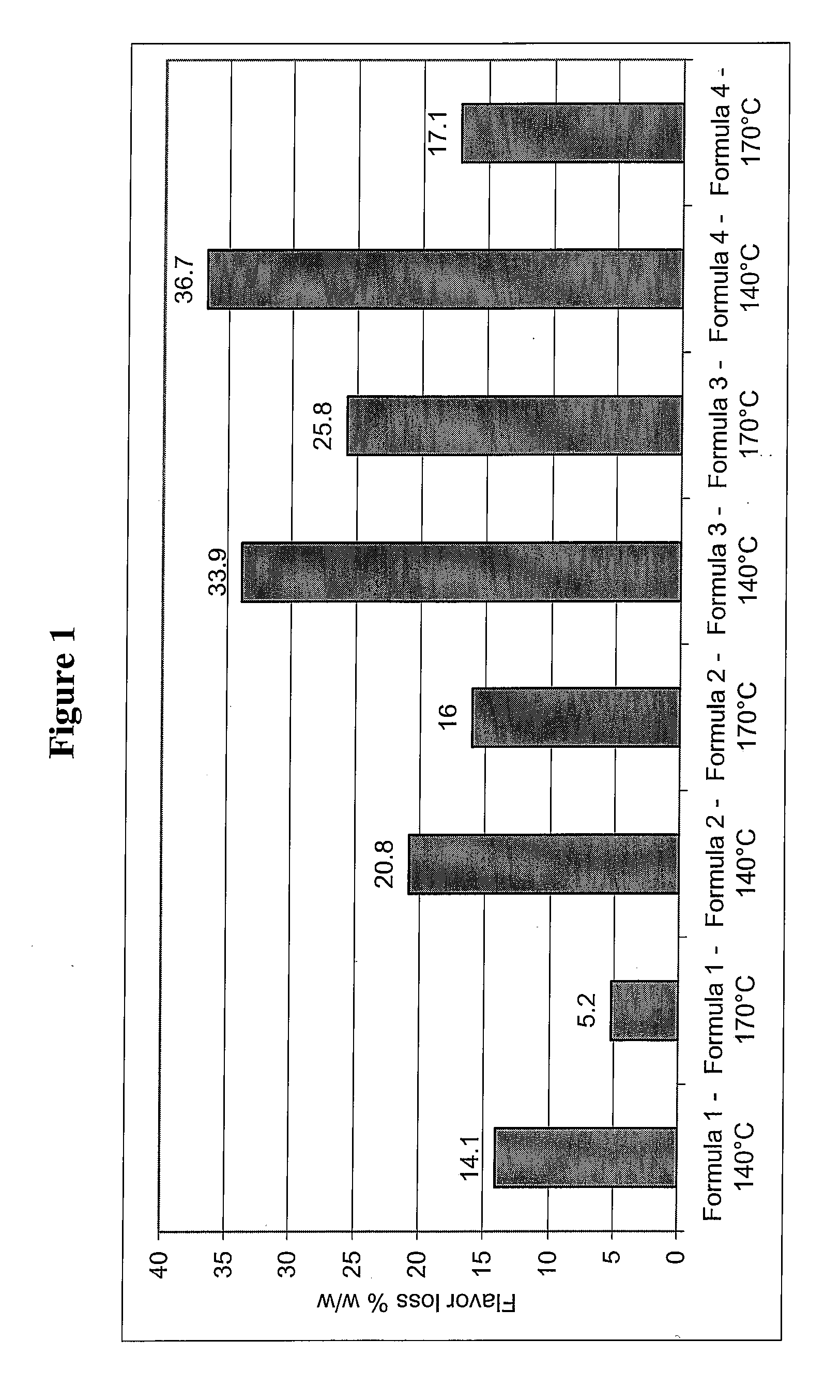Flavor or Fragrance Capsules
a capsule and fragrance technology, applied in the field of capsule preparation, can solve the problems of relatively small particles, relatively large particles become useless, and fluctuation of final concentration of active ingredients may become quite considerable, and achieve the effect of reducing volatiles
- Summary
- Abstract
- Description
- Claims
- Application Information
AI Technical Summary
Benefits of technology
Problems solved by technology
Method used
Image
Examples
example 1
Drying of Formula 1 with Inlet Air at 140° C.
[0076]A solution was prepared by mixing 295 g of Capsul® (supplied by National Strarch), 5 g of citric acid and 500 g of warm water at 50° C. in a vessel until the starch was completely dissolved. The solution was then maintained at 40° C. under gentle stirring. 200 G of limonene were poured into the above-described solution, and homogenized using a high shear rotor / stator mixer Ultra Turrax T50 rotating at 10000 rpm, until the average droplet size of the emulsion was below 2 microns. Limonene has a vapour pressure of 193 Pa.
TABLE 1Inlet temperatures and compositions of matrix materials with respective flavour lossInletFinal nativePGSucroseCapsul ®Citr. ac.LimoneneH2Ogasstarch (coating)Final flavour loadFlavour lossFormulaExample(g)(g)(g)(g)(g)(g)T° C.fraction w / ww / w%11——295520050014012.132.014.12——295520050017010.434.75.223—50245520050014010.630.920.84—50245520050017010.032.316.0355050195520050014018.325.033.965050195520050017017.827.225...
example 2
Drying of Formula 1 with Inlet Air at 170° C.
[0086]The same formulation and preparing conditions were used as in Example 1.
[0087]The processing conditions were all the same except that the main air stream was heated at 170° C.
[0088]In this example, 10.1% w / w of native starch was present in the final granules. The final flavor load was 34.7% w / w and the limonene loss was only 5.2% w / w of the initial amount.
examples 3 and 4
Drying of Formula 2 with Inlet Air at 140° C. and 170° C. Respectively
[0089]A formulation using some sucrose in the encapsulating matrix was prepared (see Table 1). The same preparing conditions were used as in Example 1.
[0090]The processing conditions were all the same as in Example 1. The inlet air temperature was 140° C. and 170° C. in Example 3 and 4, respectively.
[0091]In Example 3, 10.6% w / w of native starch was present in the final granules. The final flavor load was 30.9% w / w and the limonene loss was 20.8% w / w of the initial amount, which is rather economically significant.
[0092]In Example 4, where the granules were dried at higher inlet air temperature, 10.0% w / w of native starch was present in the final granules. The final flavor load was 32.3% w / w and the limonene loss was then only 16.0% w / w of the initial amount.
PUM
| Property | Measurement | Unit |
|---|---|---|
| diameter | aaaaa | aaaaa |
| mean diameter | aaaaa | aaaaa |
| temperature | aaaaa | aaaaa |
Abstract
Description
Claims
Application Information
 Login to View More
Login to View More - R&D
- Intellectual Property
- Life Sciences
- Materials
- Tech Scout
- Unparalleled Data Quality
- Higher Quality Content
- 60% Fewer Hallucinations
Browse by: Latest US Patents, China's latest patents, Technical Efficacy Thesaurus, Application Domain, Technology Topic, Popular Technical Reports.
© 2025 PatSnap. All rights reserved.Legal|Privacy policy|Modern Slavery Act Transparency Statement|Sitemap|About US| Contact US: help@patsnap.com

